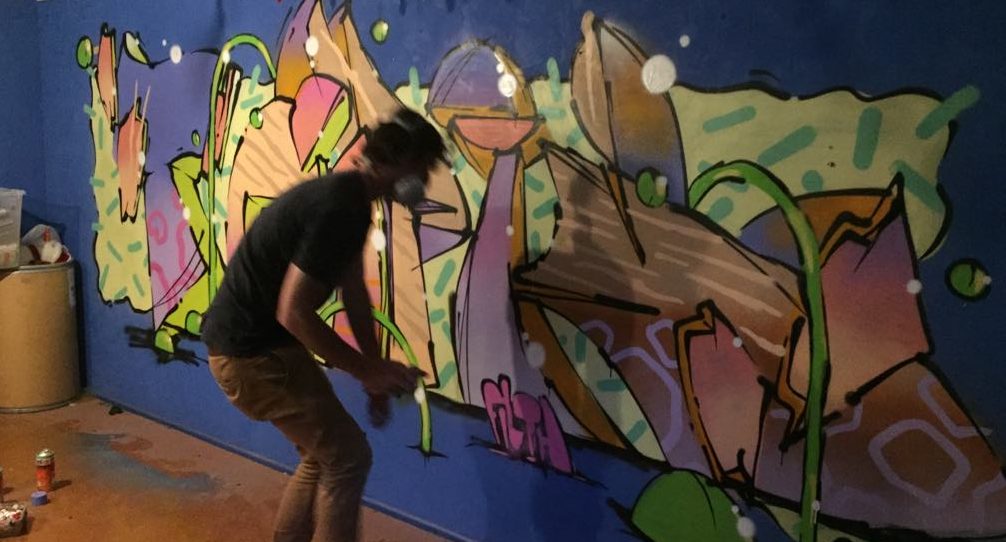When I arranged to sit down with Nick Lowry (at times known as Tepid), I wasn’t sure where the conversation might lead. This wasn’t a reflection of Nick’s temperament, he is a chill guy who is instantly likeable, instead, it was based on the reality that his work is spread in so many directions that there were almost infinite possibilities. When we started to chat, it became pretty obvious that we would sprawl across various topics, shifting back and forth, an apt reflection of Nick’s process as a maker and doer. As a graffiti artist, muralist, painter, collagist, set designer, art director, sticker maker and more, it was fascinating to see how he distinguished these practices, but also had a defined understanding of his creative impulses in a singular sense. It was quickly apparent that Nick’s compulsion to make things is driven by a deep urge, one that doesn’t necessarily require explanation or understanding, but instead is a very human condition that invokes all the contradictions of our nature. By the time we came up for air, an hour had flown by and we had discussed a raft of ideas around graffiti, surfing, music, scenic art, exploring cities, and overthinking things. It is no surprise then that this has become a two-part interview, and here in part one, we start with the diversity of his work, his introduction to graffiti and his thoughts on his hometown of Christchurch…
From graffiti, stickers and mural works, to set design and film art direction, diversity is kind of a hallmark of your work. What was the earliest creative impulse for you? Was graffiti a gateway into other creative practices, or was it more of a vehicle that harnessed your existing creative impulses?
I think it was more of a vehicle. It was probably intrigue that sparked it off. When I was twelve years old, I had a babysitter, he was probably sixteen, and he wouldn’t feed me until I smoked a joint and watched him paint freights in Belfast, which is pretty funny. So, for me it was almost this hatred of graffiti because I wasn’t getting fed unless I helped this guy out, you know? I hated it until I was about sixteen when I became mates with some guys who were painting, Fader, Astro, Raws, Venom, all those dudes. They were all mates from university. I was watching what they were doing, and I was like, this is actually a really intelligent form of art! Up until then I had always been drawing. I’d been drawing forever. I was really into, strangely enough at a young age, interior design. All through high school I was always building dioramas. So, at an early age I was exploring set design, scenic art and that sort of thing. One of my first jobs was a scenic artist in the Riccarton Players Club, at the Mill Theatre in Addington. Before that was destroyed. So, I think there is a real cross-over for me between graffiti and scenic art, in that there is a really blurry line. When I paint graffiti, I don’t paint for the ‘getting up’, I paint purely for the way colours work and for the names that I’ve chosen over the years. It’s simply a vehicle for style, like it is for a lot of graffiti writers, I guess. Like I said before, I’m just creating these little worlds and the diversity of my art just comes down to how I feel on any particular day. Some weeks I put a lot more effort into collaging or into graffiti, or into set design or muralism, or realism, or just hustling for work. I’ve never been fully immersed in anything. I don’t want to be typecast. I don’t want to be known for anything. I just do it for myself, and everything I do is simply an outlet.
There must be a consistent thread through it all though, something that unifies everything in some way, can you see the way they all interrelate?
Oh definitely…
Not only aesthetically or stylistically, but in the practice and process of each, is that something you think about?
Yeah, I guess I don’t really think that deeply into it. It’s almost like with a creative act, the more I think about it, the less I want to do it. For me being creative is a way of not thinking at all, and that’s why I probably don’t produce as much as I should. But I don’t want to have to think about producing a lot of things, because for me, that just creates pressure and I don’t like that! (Laughs)
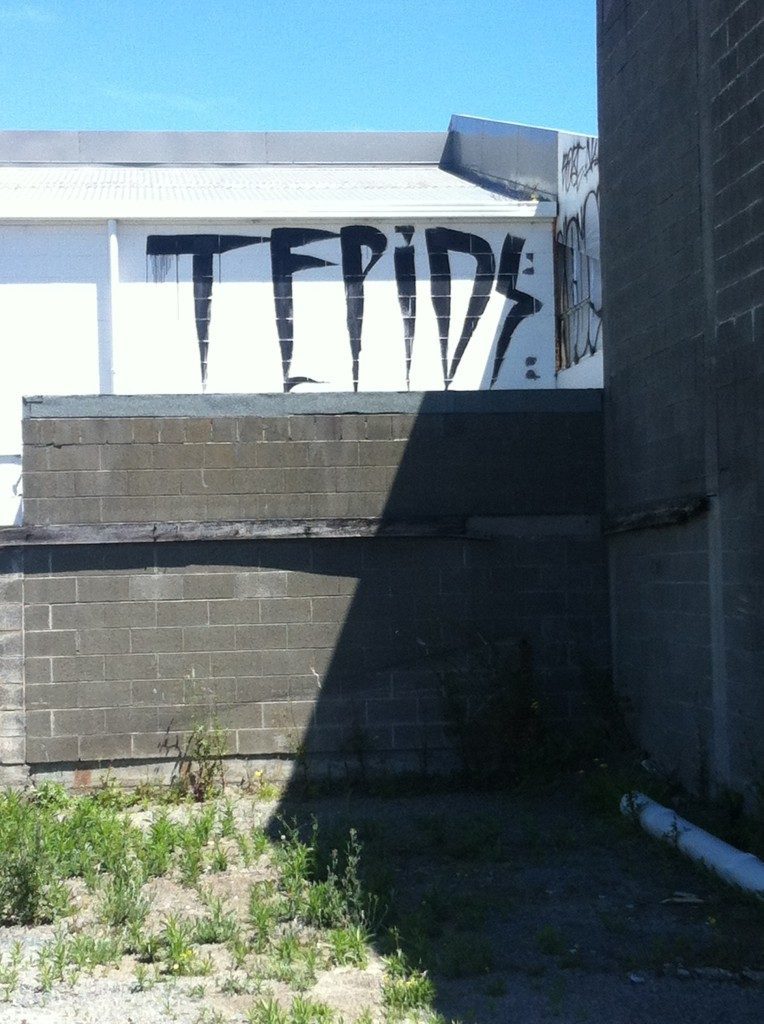
That freedom is important?
The freedom of it is really important. It is what it is, and if one week I make fifty collages and for the next three weeks I don’t do anything, it’s because I’ve transferred my energy into something else. I like to surf a lot, and that is one of my most creative outlets. If I’m not making art, I like to do that. I also like to run a lot, and that is strangely another creative outlet because a lot of thought processes go on during that time. I think having physical outlets is really important.
There is a physicality in wall painting and in set design as well, so there is inherently a connection between physical activity and the act of creation in those instances. Conversely, in the case of running there is a sense of freedom, physical but also by extension mental, while surfing offers a physical creative performance…
It’s a release of a certain type of energy. We get a taste and I think we always want to feel that energy again. I like having a diverse range of things that get me to feel differently. I don’t really think about achieving a consistent style, but sometimes, if I look around this room, if I blur my eyes a little bit, I can kind of see something. I don’t really know how to describe it. I don’t really think about what I do to the point where I can do that.
You talked about leaving things and letting them evolve subconsciously, before coming back to it when it has worked itself through…
Yeah, I just sort of nurture it in my mind and come back to it.
Do you see your work in a progressive sense? Can you look back over time and see a lineage, or are there various trajectories between different points because of that willingness to leave things? For instance, is muralism a progression from graffiti?
I think my muralism is quite immature and unrefined. it’s one of those things that is more of a hobby. Muralism is probably the hardest thing for me, because I am quite critical of what I do, and I prefer to do things for myself. With a mural, you have so much pressure to create something that’s for the viewer and I generally don’t care about the viewer! (Laughs) But at the same time I would like to produce more, and over time it is getting better and I am trying to refine the style. But I don’t visit muralism as much. Maybe I will in the future, but at the moment it isn’t a massive priority. Whereas I think set design is helping me to evolve that further because I have to work within a limited space, and I think that kind of helps set me up mentally.
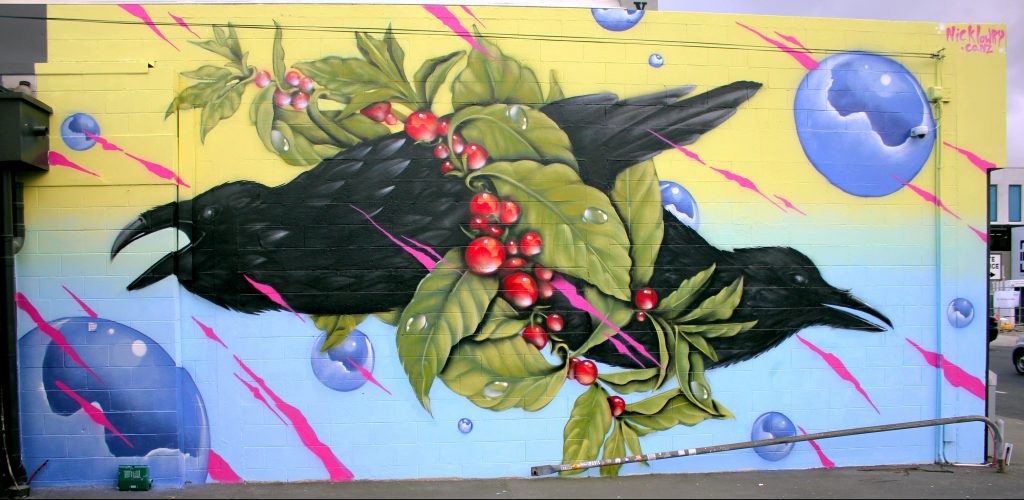
You mean when you are designing a set you are working within a defined space and creating a defined world? Which to me, kind of echoes graffiti and muralism in that you are trying to create something within the space around you…
It’s too much. With muralism, there is almost too much you can do. You aren’t restricted by physics. I like being bound and restrained; you know? If I was given three colours or something and told to only use those colours, perhaps I could manage it. But I think with muralism, it is too easy to overthink it. With set design and art direction, you are given a space and an actor or dialogue, and you are confined to that, and that’s how I like to work.
Did you train in set design at all?
No, I studied graphic design, video post-production and editing.
How deeply do you think about the conceptual approach to set design? Are you constantly thinking practically, in a real-world sense, or do you explore an abstract concept beyond the visual and how an environment might be multi-layered?
Definitely, and I think that’s the beauty of it, you are creating a world through which someone is going to speak their dialogue and it doesn’t have to be literal. In fact, they want it to be as non-literal as possible, so the actor then has a space from which to bounce off, I guess.
You’ve got to achieve that balance between the nuances of each approach…
You also have to think about lighting and shadow, and the way those elements work, so there are a lot of things to consider.
This all leads me to back track a little bit. You mentioned that you didn’t come at graffiti through the traditional ways of Subway Art and Style Wars, or even hip-hop culture necessarily…
No, it was the direct influence of my peers, this supposed babysitter! (Laughs) Just being there when it was being done. My direct influences were my friends, watching things getting destroyed, skating and things like that…
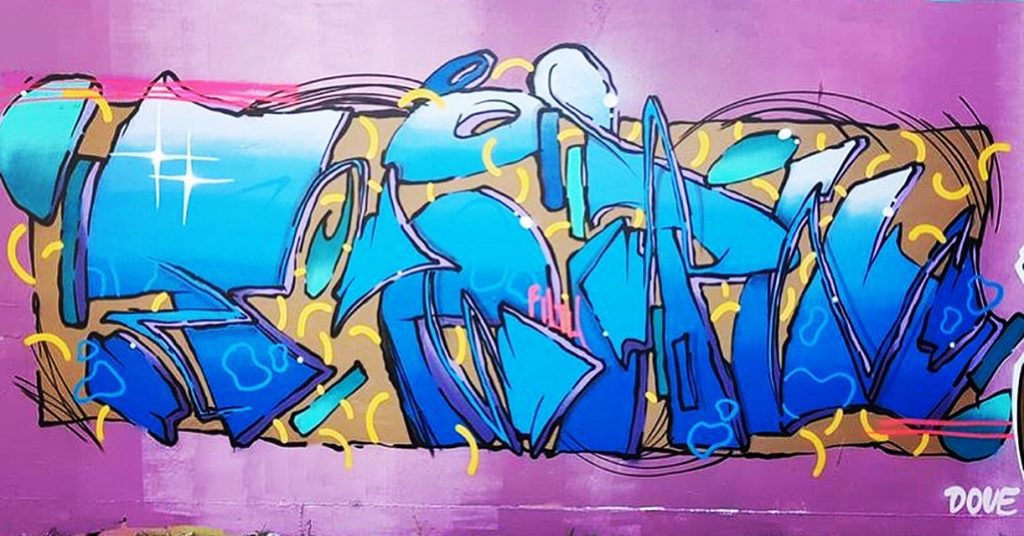
Does that mean you had more or less of a recognition of the importance of graffiti as a sub-cultural and even historical phenomenon?
I soon learnt. Once I formed that obsession with tagging and throw ups and all the rest, I quickly picked up every book I could, watched every film I could, researched every writer throughout history and then formed obsessions with certain writers and created heroes and stuff like that. So, I soon schooled myself and became obsessed with graffiti and street art.
Were you conscious of the idea of graffiti as a political act and the themes of identity and contestation? Or was that aspect always secondary to the draw of being creative? Although creativity through destruction is political in a way…
I think the importance of graffiti and my understanding of it was about being in a moment in time and the way you deliver it, the aggression behind it and being with other writers. Not to sound like graffiti is a macho thing, but you are with the crew and you are outdoing each other. I liked the idea that there was this aggressive, ‘fuck you’ element to it. The punk influences behind graffiti for me were the main thing when I was younger…
You mentioned the punk influence earlier, which is often overshadowed by hip hop, but punk is a significant influence on graffiti and street art culture…
For me, Christchurch metal was a big influence, which I guess is like the punk ethos. I was a young metal head, but I had a broad spectrum of friends, a lot were really goth, but a lot were also really G, so there was a cross over. But we were all hanging out together. There were skaters and goths and G’s at parties, everyone was hanging out together. I didn’t want to box myself into any one circle. For me, graffiti was a thing that didn’t exist in any boxes, because my social circles didn’t fit into those boxes…
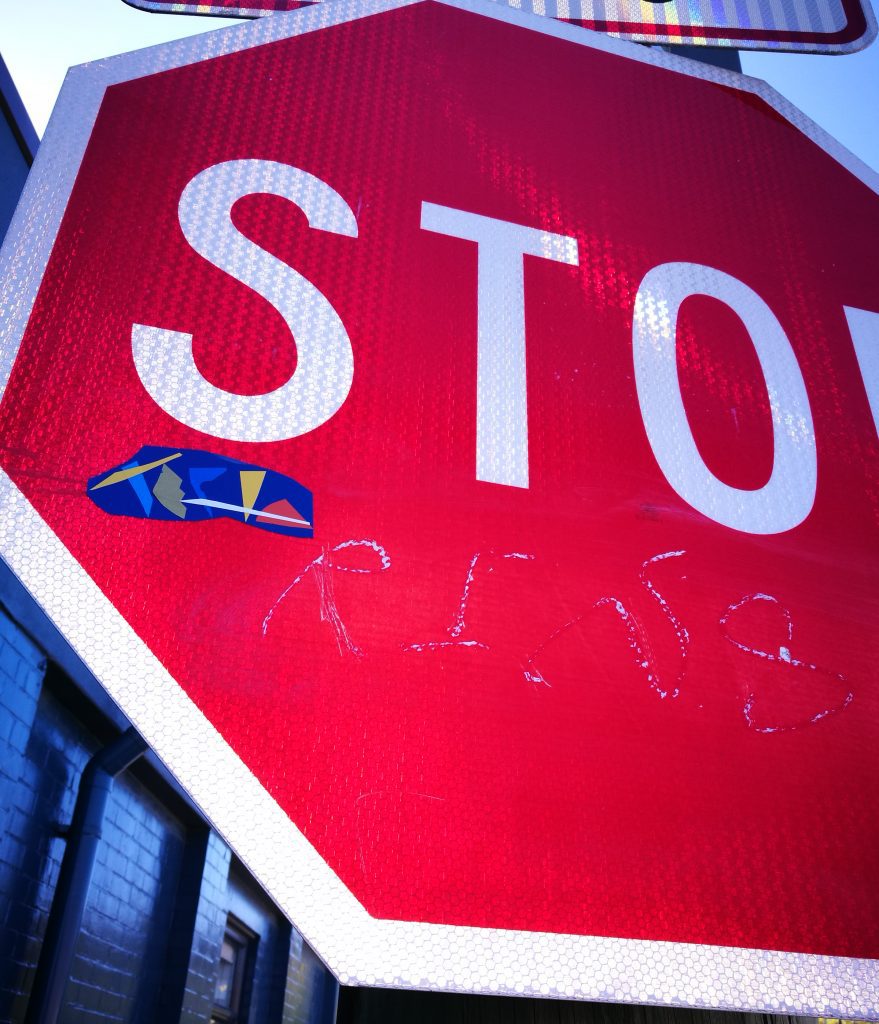
Christchurch is a small city, so it is more likely that those scenes will intermingle, right? Speaking of Christchurch, what impact has the city itself had on you as an artist? How big an impact do you think the quakes have had on the city’s creative communities?
Well, I spent a lot of my twenties away from Christchurch, in Perth, in Margaret River and in Broome in Western Australia, exploring the desert. I also spent a lot of time in Indonesia and exploring the Philippines. So, when the February 2011 earthquake hit, I was here for two months, and I was like, I don’t have to be here. I had travelled enough to know there was more out there and I could access that with a $400 plane ticket, so I was out…
So, those experiences travelling, have they influenced the way you think about the post-quake city? Has painting pre-quake given you a certain take on the city now?
I enjoy Christchurch’s dark underbelly and industrial vibes. I think it has this very rigid, grey stone element that I quite like, but that a lot of people despise. The city is kind of a juxtaposition of these lovely blue skies and then this grey, sterile, and weathered architecture, which I don’t know, is just kind of a strange mix. And then we are surrounded by natural beauty, if you are willing to go find it. I think it is the most schizophrenic environment to be in, you know? (Laughs) We have this white and seemingly uncultured city, but then we have these explosions of music, like you were saying before, the amount of music that comes out of Christchurch is phenomenal, explosions of art and artists and everything else. There is something in the water in Christchurch, for sure, for a population of 400,000. Maybe it is that energy of where we are geographically?
Since coming back to Christchurch in 2015, have you found new directions have opened up for you as a creative?
It has opened so many doors. I think Christchurch has changed, it’s not as gritty and grimy as it used to be. But for a creative, someone who is on their own, trying to hustle for work, it’s amazing. You can create so many opportunities for yourself, whatever you can envision in your mind, you can achieve, it just depends on how far you are willing to push yourself.
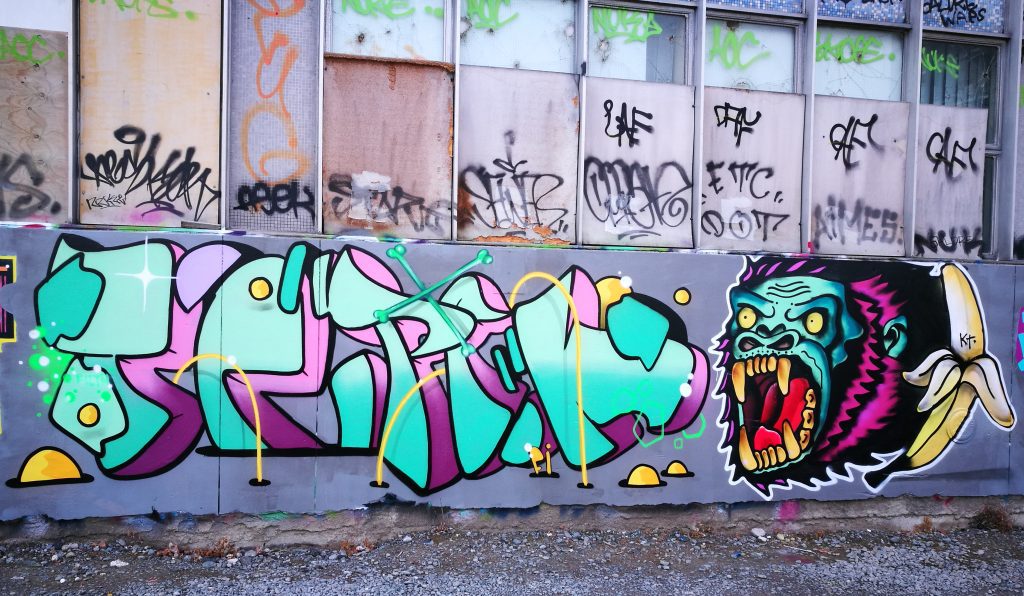
Does that surprise you, based on your experiences when you were younger?
I think those avenues probably existed then, but the situation didn’t allow us to have that train of thought. Whereas now when you come back and you are left with limited things to do, you really have to, in order to dig yourself out of a hole, you really have to dig, but you don’t have to dig too far to get what you want out of it. There are so many possibilities. There is not a lot that exists in Christchurch, so if you have an idea and you want to get it, you will get it.
It is almost a perfect storm because of the opportunities presented by the recovery, but also, I think, in our contemporary digital world, you can access and experience so many ideas that people are exploring all over the place and translate them to this environment if you want. The inspiration coupled with the opportunity is perhaps unlike any other time…
Definitely.
Although, I guess that can create a sense of homogeneity.
It can be a little bit homogenised sometimes.
I’m interested to talk about some of the more recent work you have been making, and particularly the features of fluorescent colours and wavering lines…
It’s kind of more painterly…
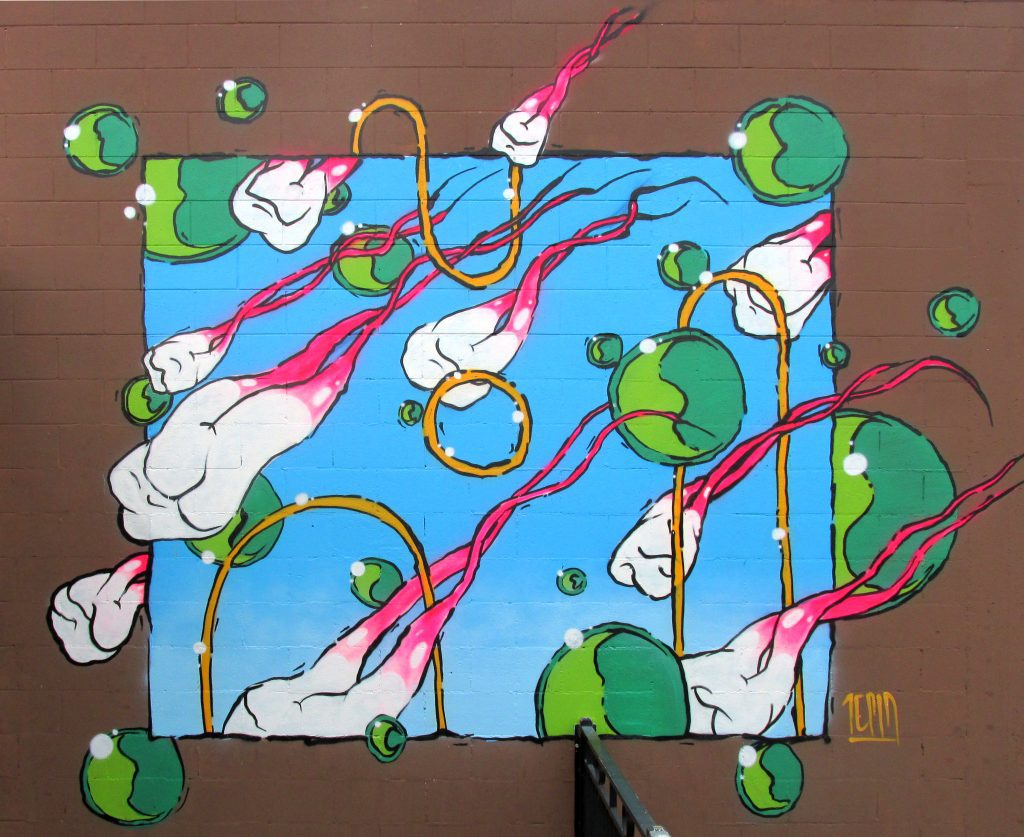
What is the inspiration for that?
Um I guess, physicality. If I’m making something, I don’t want it to look perfect, I don’t want it to look like it is clean cut or fresh. I was obsessed with painting like that in the past, but I found that as soon as I tried to paint more fluidly, I enjoyed it more. I think it’s more human to paint as rushed and as aggressively as possible. It’s like that classic car crash advertisement: ‘The faster you go the bigger the mess.’ The bigger the mess is awesome! So, much to the bane of all my mates who I paint with, I fucking rush my paintings. I always rush my graffiti, and it’s not because I want to get in and get out, it’s because I feel like I want to spew it out, I want to vomit my shit on the wall, you know? I don’t want to think about too much, because I think you can overthink things and you can overcook it. It’s not like graffiti is ‘get in, get out’, because I’m not doing anything illegal at the moment, sadly. I wish I could, but I’m just an old man! But when I do paint a piece on a wall, I just literally want to smash it…
Is it a need to replicate the energy you get when you do paint illegally? By painting with that speed, there’s an energy that echoes being somewhere you aren’t supposed to be, doing something you aren’t supposed to do, and the work will reflect that…
Definitely. I painted illegal graffiti when I was younger and I got caught enough to be like, fuck! But graffiti is graffiti and if you are not rushing it, why are you painting it? That’s the whole expression, to smash it out. It is a violent art form. As chill as you are, I think the point of graffiti for me is to make it look like it’s going to smash you in the face. I like things that look violent and have that emotional response, like you are going to get fucking sliced or whatever. But then I like to create these really funky colour schemes as well, with really soft gradients, which is my connection to nature, so maybe one day I want to die on the hills violently! I don’t know, maybe I want to get eaten by a shark? Maybe I try to create pieces that look like a violent beautiful death, or something…
Stay tuned for Part Two…
Follow Nick on Instagram or visit his website www.nicklowry.co.nz…

